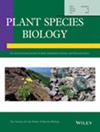Phytolacca americana L.在其入侵范围内的发芽生态学
IF 1.3
4区 生物学
Q4 ECOLOGY
引用次数: 0
摘要
外来物种入侵是一个世界性问题,萌芽过程有助于了解外来物种的入侵特征及其对全球气候变化的预期反应。美洲金雀花是意大利最具入侵性的植物之一,我们测试了不同种群(来自不同海拔地区)的光照、温度和低温分层对种子萌发的影响。根据我们的分析,P. americana 产生的种子数量特别多,有可能在土壤中存活很长时间。经过低温层积和暴露在较高温度下的种子,无论在光照还是黑暗条件下,都能更快地萌发,萌发率更高,T50更短。在最高海拔(海拔 337 米)采集的种子在所有测试的温度条件下都能发芽,但与在较低海拔(海拔 5 米和 50 米)采集并在温暖和中等温度条件下测试的种子相比,发芽率较低,T50 较长。总的来说,美国鹅掌楸似乎能适应中温(在低海拔地区)和中低温(在最高海拔地区),并能提高暴露于低温层的种子的发芽率。这些结果表明,在气候变化的情况下,美洲鹅掌楸的入侵性在未来可能会增加。本文章由计算机程序翻译,如有差异,请以英文原文为准。
Germination ecology of Phytolacca americana L. in its invasive range
Invasive species are a worldwide problem, and the germination process is useful to understand the characteristics that allow alien species to be invasive and their projected response to global climate change. Phytolacca americana is one of the most invasive plants in Italy, and we tested, for different populations (from different altitudes) how light, temperature, and cold stratification affect seed germination. According to our analyses, P. americana produces an exceptionally high number of seeds that may potentially survive in soil for extended periods. Seeds subjected to cold stratification and exposed to warmer temperatures, both in light and darkness, exhibited faster germination, with a higher germination rate and a shorter T50. Seeds collected at the highest elevation (337 m a.s.l.) have germinated in all tested thermal conditions, albeit with a lower germination percentage and a longer T50 compared with seeds collected at lower elevations (5 and 50 m a.s.l.) and tested under warm and moderate temperatures. In general, P. americana seems to adapt to moderate‐warm temperatures (at low elevations) and moderate‐cool temperatures (at highest elevations) and appears to increase germination with seeds exposed to cold stratification. These results, in a scenario of climate change, show that the invasiveness of P. americana may increase in the future.
求助全文
通过发布文献求助,成功后即可免费获取论文全文。
去求助
来源期刊

Plant Species Biology
生物-生态学
CiteScore
2.70
自引率
14.30%
发文量
36
审稿时长
>12 weeks
期刊介绍:
Plant Species Biology is published four times a year by The Society for the Study of Species Biology. Plant Species Biology publishes research manuscripts in the fields of population biology, pollination biology, evolutionary ecology, biosystematics, co-evolution, and any other related fields in biology. In addition to full length papers, the journal also includes short research papers as notes and comments. Invited articles may be accepted or occasion at the request of the Editorial Board. Manuscripts should contain new results of empirical and/or theoretical investigations concerning facts, processes, mechanisms or concepts of evolutionary as well as biological phenomena. Papers that are purely descriptive are not suitable for this journal. Notes & comments of the following contents will not be accepted for publication: Development of DNA markers. The journal is introducing ''Life history monographs of Japanese plant species''. The journal is dedicated to minimizing the time between submission, review and publication and to providing a high quality forum for original research in Plant Species Biology.
 求助内容:
求助内容: 应助结果提醒方式:
应助结果提醒方式:


